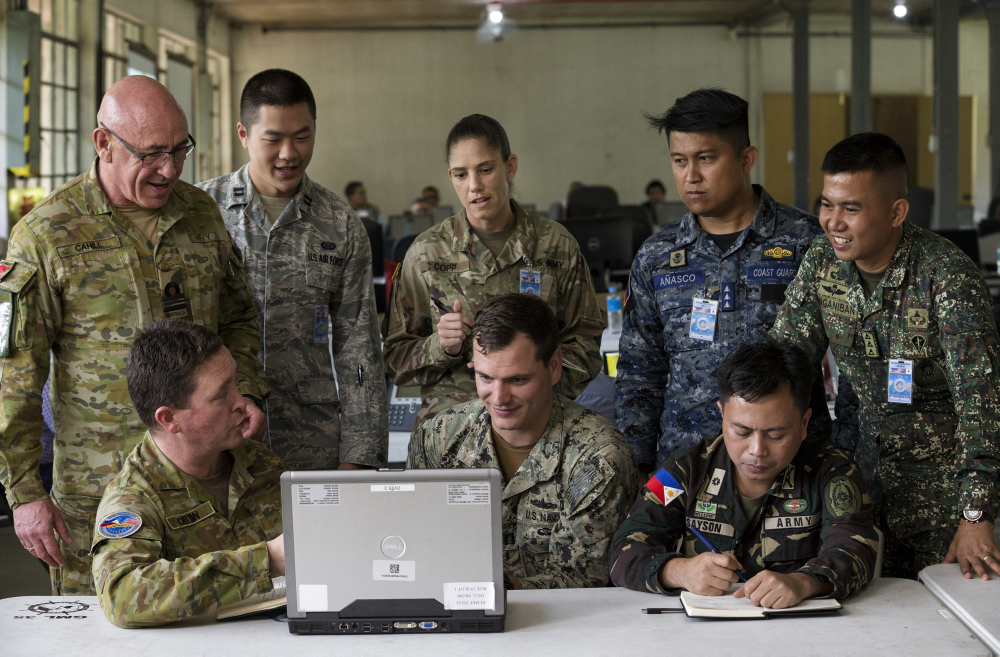
Last week, the
Asia Pacific Pathways to Progress Foundation and the
Griffith Asia Institute co-hosted a Philippines–Australia Track II dialogue in Manila, focusing on the security dimension of the relationship. It brought together academics, analysts and practitioners to talk about the security challenges facing both countries, as well as their policy responses. A key message for Australia was the need to think about options for further strengthening our strategic ties with this important Southeast Asian state beyond the battle for Marawi.
The terrorist siege in that southern Philippine city provided Canberra with an opportunity to boost defence relations by supplying much-needed assistance. The provision of surveillance support to the Armed Forces of the Philippines, in the form of AP-3C Orion aircraft, was particularly valued. Since then, the Australian Defence Force has stepped up its engagement by training Philippine soldiers in combined urban operations to enhance their capacity to address similar scenarios in the future.
While cooperation on counterterrorism will continue to be an important aspect of Australia–Philippines defence relations, it should be embedded within a broader strategic relationship. In particular, the two countries need to work together to manage a bigger strategic challenge: China’s quest for regional dominance and its ongoing efforts to turn
the South China Sea (SCS) into a Chinese ‘lake’.
The geopolitical significance of the Philippines in our region is clear. Despite the depredations of the authoritarian populism of its current president, Rodrigo Duterte, the country remains one of Asia’s largest democracies. It has a burgeoning, young and increasingly better-skilled population of over 100 million people. It’s also
one of Southeast Asia’s best-performing economies, alongside China and Vietnam, with GDP growth predicted to remain above 6.5% out to 2020.
Moreover, it’s a ‘frontline state’ in the emerging competition for the SCS because of its close proximity to some disputed islands and features. It sits in what some in Beijing term the ‘first island chain’ off China’s east coast. Its location makes the country a potential ‘barrier’ against a future bout of Chinese military expansionism and a putative ‘springboard’ for US-led operations against China’s People Liberation Army (PLA). As
Stephen Biddle and Ivan Oelrich point out, Philippine territory could be utilised to deny the PLA control over parts of the SCS by establishing an ‘anti-access/area denial’ perimeter.
Like Australia, the Philippines doesn’t want to live in a China-dominated order. Notwithstanding Duterte’s recent friendly overtures to Beijing, as
Peter Chalk’s recent ASPI report points out, the Philippines hasn’t walked away from the US alliance. Many in the political elite in Manila (as well as in the bureaucracy, the military and the wider population) continue to be deeply opposed to China’s encroachment on what they consider sovereign Philippine territory at
Scarborough Shoal, seized by Chinese forces in 2012, and to the
continued harassment of Philippine fishermen by China’s coast guard and maritime militia.
Driven by these concerns, the AFP is investing—albeit slowly—in territorial defence, with a long-term objective of acquiring a deterrent capability against China. The Philippine government just announced a
record budget of US$5.6 billion for the five-year ‘Horizon 2’ defence modernisation program, with the lion’s share earmarked for air and naval capabilities. The future ‘Horizon 3’ program is likely to include more money for further upgrades, including the acquisition of submarines. These investments are very modest from a regional perspective, and defence spending remains well below 1% of Philippine GDP. But they signal an important, if incremental change in the country’s defence policy.
Australia doesn’t take sides in territorial disputes in the SCS. But Canberra has repeatedly stated its deep concern about China’s attempt to change the territorial status quo in the region and to challenge the wider ‘rules-based order’, as both the 2016 Defence White Paper and 2017 Foreign Policy White Paper make clear.
In this context, investing in strategic ties with the Philippines must be a key priority for Canberra. Australia should offer to upgrade bilateral ties to a ‘strategic partnership’ akin to the
one just concluded with Vietnam, and ensure high-level dialogue is maintained, with regular visits by senior ministers and officials.
Australia should also explore opportunities to include the Philippines in trilateral security or defence dialogues, involving Japan, Singapore, the Republic of Korea and the United States. These moves would send an important signal to the region about Australia’s willingness to play a more active role in shaping the security of Southeast Asia and about the Philippines’ geopolitical significance in the region.
At the same time, Canberra should seize the opportunity and offer assistance to strengthen the Philippines’ territorial defence capabilities, including in hard-edge areas such as air defence and anti-submarine warfare. It could also explore the possibility of more regular sharing of strategic assessments of Chinese intentions and capabilities, and information about the disposition of naval and coast guard assets, as well as other fishing vessels.
Enhancing the strategic relationship in these ways would be important steps in pushing back against Beijing’s revisionist claims and its attempt to establish effective control over the SCS.
[8] continued harassment of Philippine fishermen by China’s coast guard and maritime militia: https://www.reuters.com/article/us-southchinasea-philippines-china/philippines-asks-china-to-stop-coast-guard-from-taking-fishermens-catch-in-scarborough-idUSKBN1J717Q
 Print This Post
Print This Post